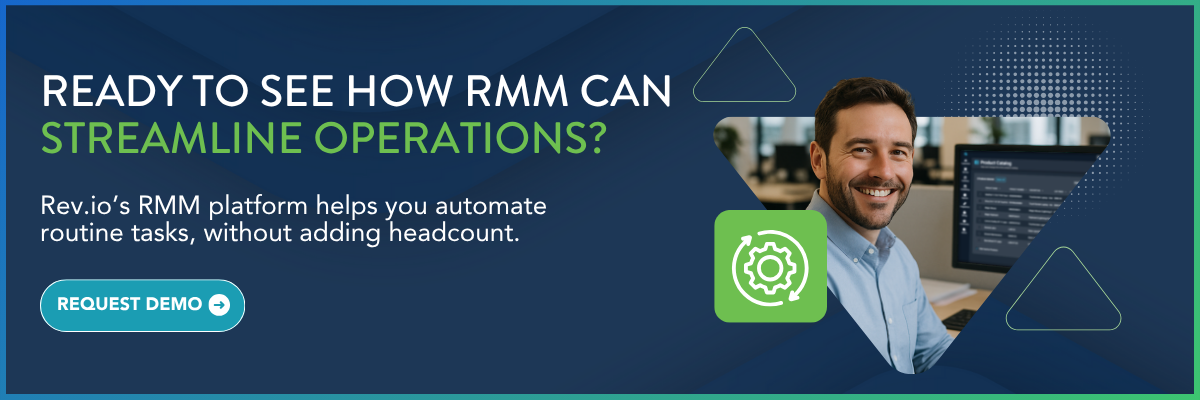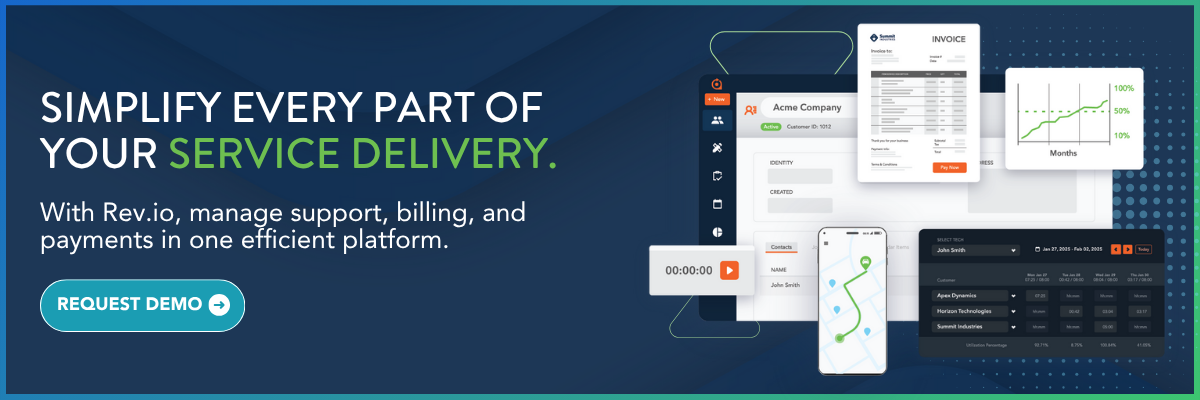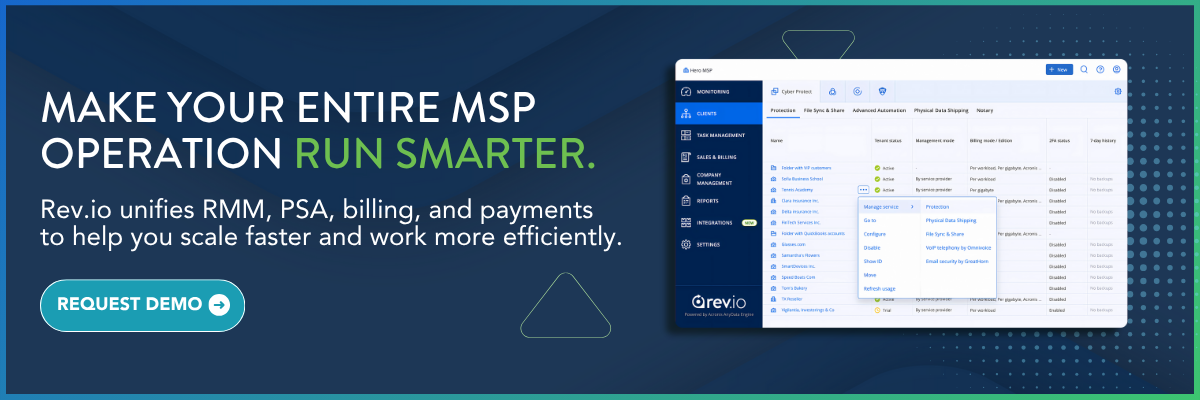You didn’t launch your MSP to drown in tickets, chase down patch alerts, or spend nights firefighting issues that could’ve been prevented. But far too many service providers operate in reactive mode, juggling disconnected tools, and watching technician morale drop as the workload piles up.
This can cause client satisfaction to slip, growth to stall, and your best techs to burn out. You’re not doing anything wrong, but the model itself isn’t built to scale.
That’s where Remote Monitoring and Management (RMM) comes in. By shifting from break-fix chaos to proactive, automated service delivery, MSPs see measurable improvements; some report up to an 85% reduction in critical IT failures, slashing downtime and emergency escalations.
In this guide, we’ll break down 12 practical, business-impacting benefits of RMM for MSPs, especially when paired with a unified platform that brings PSA, billing, and payments together in one system. Whether you’re scaling up or just trying to get your evenings back, this is the toolset that helps you work smarter.
What Is RMM for MSPs and Why Does It Matter?
RMM software is a platform that gives you complete visibility and control over your clients' devices and networks, from anywhere. It lets you monitor systems, apply patches, configure alerts, and resolve issues remotely, without sending a tech onsite or manually logging into each device.
With the right RMM in place, you can reduce manual tasks, respond to issues faster, and prevent problems before they impact your clients. That shift from reactive support to proactive service delivery is what enables you to scale efficiently while keeping your team focused and productive.
RMM tools are especially valuable if you're supporting hybrid or remote-first clients. You can manage hundreds of endpoints without expanding headcount, and keep your operations lean even as you grow. Many MSPs see up to a 40% boost in operational efficiency after adopting RMM software.
12 Benefits of RMM for Your MSP
RMM software helps you move from a reactive support model to proactive service delivery. Instead of putting out fires, your team can stay ahead of issues, streamline workflows, and deliver consistent, high-value service across your client base. These benefits are foundational to running a more efficient, scalable, and profitable MSP.
Benefits 1-4: How RMM software improves MSP efficiency and productivity
Manual, repetitive tasks slow your team down and increase the risk of human error. With RMM software, you can automate routine processes and gain centralized oversight. All from a single platform. These improvements help you reduce ticket volume, increase response times, and deliver service with fewer interruptions.
1. Automates Routine Tasks
Repetitive maintenance like patching and software updates doesn’t need to consume technician hours. RMM software automates these tasks, reducing manual effort and freeing your team to focus on billable or strategic work.
- Automatically handles patches, updates, and system checks
- Reduces human error and technician burnout
- Increases time available for higher-value projects
2. Centralized visibility from a single dashboard
Without centralized oversight, managing multiple systems becomes chaotic. RMM tools bring everything into one place, giving you the clarity to identify and resolve issues quickly.
- Real-time visibility across all client endpoints and devices
- Fewer tool switches, faster diagnostics
- One dashboard to monitor, triage, and act
3. Remote troubleshooting and remediation
Every on-site visit costs time and money. RMM software lets your team resolve issues remotely, faster, and with less disruption to the client.
- Secure remote access for immediate troubleshooting
- Improved first-touch resolution
- Fewer truck rolls and faster turnaround times
4. Real-time monitoring and proactive alerts
Waiting for a client to report a problem puts you behind. Real-time alerts help your team stay ahead of issues and take action before they become critical.
- Detects anomalies and downtime early
- Enables automation-based responses to common problems
- Minimizes client-impacting outages
Benefits 5-8: How RMM tools help you scale efficiently and reduce costs
Scaling your MSP shouldn’t mean hiring more technicians or layering on more tools. RMM platforms let you grow your client base while keeping operations lean and cost-effective. With automation and centralized control, you can increase capacity without increasing complexity.
5. One tech can manage hundreds of endpoints
RMM software multiplies the impact of every technician. With automation and remote access, a single team member can monitor and support a large number of devices, no matter where they are.
- Amplifies technician productivity
- Lowers cost per endpoint supported
- Enables growth without adding headcount
6. Lower support costs via automation and remote resolution
Support costs add up quickly when you're handling every issue manually. RMM tools help you prevent problems before they happen and fix them faster when they do.
- Proactively detect and resolve issues before clients call
- Cut down on travel costs for site visits
- Keep your help desk focused on complex, high-priority tickets
7. After-hours support cost reduction
Emergencies outside of business hours can burn out your team and inflate labor costs. RMM lets you schedule routine tasks, updates, and maintenance for overnight hours, without needing someone to be on call.
- Schedule patching and backups during non-peak times
- Reduce overnight staffing needs
- Improve technician work-life balance
8. Geographic flexibility
Whether your clients are across town or across the country, RMM software gives you the ability to support them seamlessly. It’s a perfect fit for hybrid work environments and growth into new markets.
- Support clients in any location from a central office
- Expand without opening new physical locations
- Serve remote-first businesses more effectively
Benefits 9-12: How RMM software enhances client experience and drives MSP growth
Client expectations are rising. They want uptime, transparency, and fast results. RMM helps you deliver consistent service, prove your value, and build trust that turns one-time projects into long-term partnerships.
9. Improved uptime and faster response
Your clients rely on you to keep their systems running. With RMM in place, you're able to minimize disruptions and respond quickly when something goes wrong.
- Perform proactive maintenance that prevents downtime
- Resolve issues faster with real-time insights and automation
- Strengthen client trust by meeting SLAs more consistently
10. Automated reporting and QBR insights
Clients want to see the value you provide, not just the hours you bill. RMM reporting helps you show your work and guide strategic conversations during QBRs.
- Deliver clear, professional reports on system health and support activity
- Use data to drive client conversations and renewals
- Position yourself as a proactive partner, not a reactive vendor
11. Streamlined compliance and patch management
Staying compliant can be complex, especially for clients in regulated industries. RMM helps you manage patching and policy enforcement automatically, reducing risk for both you and your clients.
- Automatically apply OS and software patches
- Align with HIPAA, SOC, and other industry standards
- Reduce liability through consistent, auditable processes
12. Frictionless onboarding of new clients
Getting new clients up and running should be fast and reliable. RMM lets you standardize your onboarding process so you can deploy services consistently and at scale.
- Use prebuilt templates and automated agents to reduce manual work
- Speed up time-to-value for new accounts
- Eliminate setup errors and ensure smooth handoffs across your team
Why RMM Works Best as Part of a Unified Platform
RMM tools are powerful on their own, but if they operate in isolation, you're still stuck stitching together disconnected systems. That means double data entry, reporting blind spots, and delays between service and billing. To maximize efficiency and margin, RMM works best when it’s tightly integrated with your PSA, billing, and payments stack.
Here are three ways integrating RMM with your PSA, billing, and payments platform helps you run a more efficient, accurate, and growth-ready MSP:
1. Unify RMM, PSA, billing, and payments for full quote-to-cash automation
When your tools are unified, service delivery flows directly into billing and revenue, without manual effort or missed billables. Rev.io connects your RMM, PSA, and payments into one seamless system.
- Automatically generate invoices based on real-time RMM data
- Eliminate handoffs between ticketing and billing
- Speed up cash flow with faster invoice delivery and payment collection
2. Reduce tool sprawl and cut administrative overhead
Tool fatigue is real. Juggling multiple vendors and logins adds cost, complexity, and training time. A unified platform provides a streamlined toolset that functions better because it works together.
- Replace siloed tools with one integrated platform
- Reduce software costs and context switching
- Free up admin staff from duplicate entry and sync errors
3. Centralize service, billing, and payments in a single source of truth
With Rev.io, your client data, service history, and billing info all live in one place. That means fewer mistakes, better reporting, and more trust from your clients.
- Align service delivery and invoicing for accuracy
- Simplify internal operations with shared visibility across teams
- Strengthen client relationships with consistent, transparent communication
Conclusion: RMM Is the Backbone of Modern MSPs
Proactive service delivery is the foundation of every high-performing MSP. With RMM software in place, you're able to eliminate firefighting, reduce manual work, and deliver a more consistent experience to your clients.
But the true operational edge comes when RMM is part of a unified platform. Rev.io’s RMM, combines PSA, billing, and payments in one system allows you to automate quote-to-cash workflows, improve billing accuracy, and accelerate revenue, all while reducing complexity.
Request a demo to see how Rev.io unifies RMM, PSA, billing, and payments to simplify your operations and support sustainable growth.
FAQs
What is RMM software and how does it help MSPs?
RMM (Remote Monitoring and Management) software allows MSPs to monitor client endpoints, automate routine tasks, and resolve IT issues remotely. It helps MSPs shift from reactive “break-fix” models to proactive service delivery—improving uptime, reducing support costs, and increasing technician efficiency.
What are the key benefits of using RMM tools?
RMM tools give MSPs the ability to:
- Automate patching, updates, and system maintenance
- Remotely monitor and manage devices across client environments
- Detect and resolve issues before they impact clients
- Scale service delivery without scaling technician headcount
- Provide real-time visibility into IT infrastructure health
Can small MSPs afford RMM solutions?
Yes, many modern RMM platforms offer flexible pricing based on the number of endpoints or users, making them accessible for small and growing MSPs. Even for smaller teams, the time savings, automation, and reduced ticket volume can quickly offset the investment.
How does RMM differ from a PSA tool?
RMM focuses on automating and monitoring IT systems, while PSA (Professional Services Automation) platforms manage business operations like ticketing, time tracking, and project workflows. Together, they provide full visibility and control over both service delivery and business processes.
Is there value in combining RMM with billing and payments?
Absolutely. Integrating RMM with billing and payments eliminates manual data entry, ensures accurate invoicing based on actual services delivered, and streamlines the quote-to-cash process. Platforms like Rev.io unify RMM, PSA, billing, and payments into one system—helping MSPs reduce complexity, improve cash flow, and scale faster.


